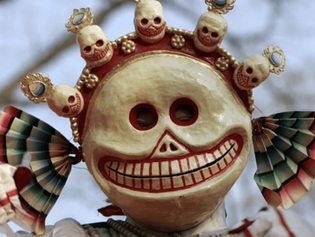- The Origin of the Sacred Dance
- Types of the Cham Dance
- Music of Tibet
- Tibetan Mask and Monk Costume
- Mongolian Traditional Dance
- More Musks
- Our YouTube video about Tibetan Dancing
The sacred Tibetan dance is called Cham, or Tsam in Mongolia. It serves as a form of meditation and a means to overcome inner enemies, such as greed, hate, ignorance, selfishness, ego, anger, lust, jealousy, arrogance, and delusion. The primary objective of the dance is to promote compassion and purify karma.
The Origin of the Sacred Dance
The origin of Cham dance is not clear, but it is said to have been kept secret for a specific reason. According to legend, the Cham dance tradition was started by Guru Padmasambhava in the 8th century to symbolize the triumph of good over evil. According to the legend, King Trisong Detsen of Tibet called upon Guru Padmasambhava to rid a place where the Samye monastery now stands of evil spirits. Guru Padmasambhava performed a dance ritual to bless the land and restore its sanctity. Over time, this ritual evolved into the elaborate Cham Dance, which is now a distinctive practice in Tibetan and Mongolian Buddhism.
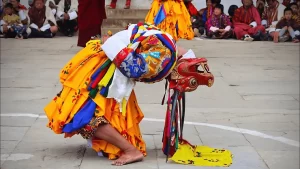
Chan dance’s purpose is to vanquish the inner enemy within us. In Buddhism, ignorance is considered our primary adversary, and according to this belief, inner enemies are the root causes of human suffering.
The dancer must visualize themselves as the deity corresponding to the mask they wear. Distraction is to be avoided at all costs. Originally, these dances were not meant for entertainment; instead, the audience sought blessings from the performers. Every participant, including lamas, dancers, and spectators, would maintain intense focus and enter a meditative state.
Types of the Cham Dance
Cham dances often depict stories from the life of Padmasambhava, the 9th-century Nyingma teacher, as well as other Buddhist deities.
Some of the main topics include the Great Debate, which is held annually at Kumbum Monastery in Qinghai.
Another topic is the assassination of the cruel Tibetan king, Langdarma, in 841 CE by a monk named Lhalung Pelgyi Dorje. This dance is typically performed on the eve of Losar, the Tibetan New Year, symbolizing the victory of good over evil.
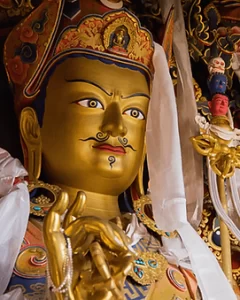
The Black Hat dance is a Vajrakilaya dance and is the dance most frequently depicted in paintings. This dance is performed by Buddhist monks and serves two significant purposes: achieving enlightenment and vanquishing evil forces. The dancers often hold a skull and a scarf tied together, which is then attached to the hilt of a phurba, a three-sided ritual dagger.

Music of Tibet
The dances are accompanied by a small orchestra consisting of traditional wind and percussion instruments, such as the Dramyin, cymbals, tambourines, drummers, trumpets, conch shells, and bone flutes.
The musicians have to play according to a certain rhythm: Dra, Gyek, Pum, Jom.
Dra represents the inner enemy, Gyek signifies distraction, Pum symbolizes unity, Jom represents overcoming.
This is the special sequence that must be followed while playing the musical instruments. The musicians must achieve perfect harmony of body, speech, and mind through meditation. All the sounds, including the lama’s chanting, the rhythm of their cymbals, and trumpets, must be in perfect synchronization.
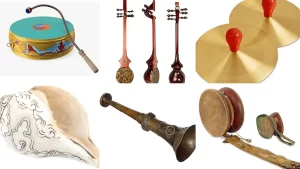
Left-to-right and top-to-bottom: Dramyin, cymbals, tambourines, drummers, trumpets, conch shells
Tibetan Mask and Monk Costume
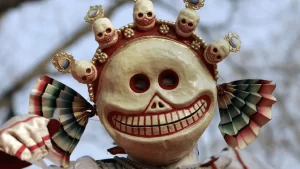
The masks are larger than a person’s head and are made of paper-mâché. They feature large wigs made of yak hair. Mongolian masks symbolize the actual presence of a deity and are never pierced through the eyes. The dances must demonstrate the gods’ care, which is why the eyes cannot be pierced.
As a result, the performers had to look through the mouths of the masks, adding extra height to their appearance.
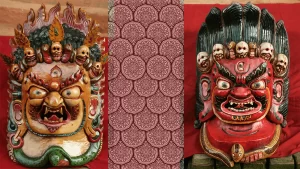
Functioning as the temporary residence of gods and demons, these masks are similar to statues and are treated as sacred objects. When not in use, they were stored in monasteries and honored in daily rituals.
The masks worn in Cham represent various characters from Tibetan Buddhist folklore. These masks encompass a range of characters, from benevolent to fearsome, representing famous figures from historical episodes or Tibetan culture. The fierce appearance of these masks is not literal but rather a symbolic representation designed to ward off our inner enemies: greed, hate, ignorance, selfishness, ego, anger, lust, jealousy, arrogance, and delusion.
Mongolian Traditional Dance
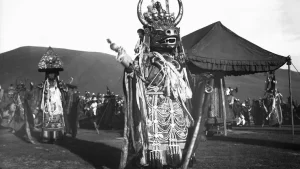
The Tsam dance originated in Tibet and arrived in Mongolia during the 1800s. Tsam incorporates both tantric and older shamanistic elements of dance.
It became a significant part of Buddhism in Mongolia before being banned under communist rule in 1924. The Stalinist purges in Mongolia resulted in the destruction of over 700 monasteries and the deaths of tens of thousands of Mongolian monks and lamas. This mass murder of much of Mongolia’s monastic culture posed a threat to the survival of the Tsam dance, as few practitioners survived the purges.
With the dissolution of the Soviet Union in 1991 and the introduction of a new constitution permitting religious practices, the practice and performance of Tsam dancing have grown significantly. Many of the costumes and masks used in Tsam dances survived the Soviet purges of monasteries and temples by being buried, hidden, or stored in museums, such as the Choijin Lama Temple Museum.
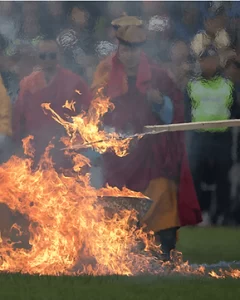
“Lingka” sacrifice
In the 19th century, more than 500 of the 700 monasteries in Mongolia had their own version of the dance. Mongolian-produced Tsam masks are exceptionally large and possess an artistic expressiveness rarely matched in other countries.
The Mongolian Tsam usually starts with a performance by two figures wearing skull masks and skeleton costumes. These two characters represent the Lords of the Charnel Grounds. Through specific rituals and repeated dances, the pavilion where the Tsam dances occur is transformed into a mystic Charnel Ground where people can discover the root of desire and attain higher knowledge.
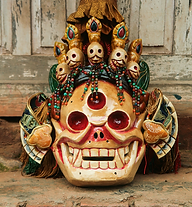
Traditional Skeleton Mask
The White Old Man is a shamanistic figure that was part of the pre-Buddhist religion Bon. Originally, he is believed to be the progenitor of various families. He is also considered the protector of herds and the provider of harvests. Additionally, he is regarded as a God of Fertility. On the other hand, he is seen as a symbol of long life.
The next figure in Tsam is Khashin Khan and his eight sons, each of whom holds a different musical instrument in their hands. Khashin Khan is portrayed as the ruler of Kashmir and typically wears a long dress with a necklace of long rose quartz malas around his neck.
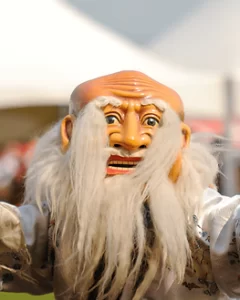
Groups of characters wearing demonic masks appear and dance around the circle, including the God of War, the Guardian of Religion, and the God of Wealth, with the purpose of destroying all evil.
The festival concludes with a lama representing The God of Wealth, wearing a stag mask, who tears apart a special cake called ‘lingka.’ A sacrificial offering, shaped like a human figure made from dough, is ritually cut into pieces and scattered in the four cardinal directions. This act symbolizes the destruction of the enemy of Buddhism and the purification of the human soul from the three evils of ignorance, jealousy, and hatred. Some scholars have suggested that this practice is connected to pre-Buddhist human sacrificial ceremonies in Mongolia.
The only participants in the ritual who do not wear masks represent the earliest stratum of pre-Buddhist Tibetan religion called Bonpo. Bonpo, much like the popular Mongolian religion, had distinct shamanistic characteristics.
The final character to appear in the Tsam square is Yama, the God of the Realm of Death and Supreme Judge of the Dead, whom the Mongols refer to as Erlig Khan. He typically wears a Black Buffalo mask and carries a lasso for capturing souls in one hand and a skeleton-shaped scepter in the other. His arrival at the head of the procession marks the climax of the ritual.
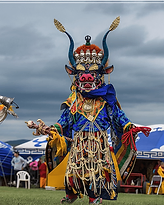
More Musks
- Want to receive our weekly newsletter? Sign up here.
- Follow us on Instagram, and Facebook.
- Subscribe to our YouTube channel.
- Looking for more great content? Dig into our blog.
- Email us at hi@meditationmarathon.me

